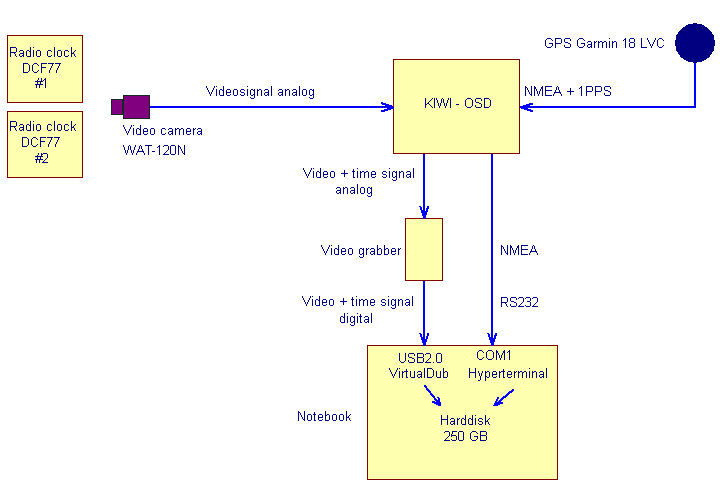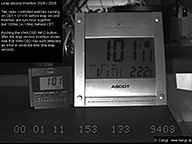The 24th leap second at the turn of the year 2008/2009
(UTC = TAI - 34s)
| Frameless version of this page |
The insertion of a leap second at the turn of the year 2008/2009
The International Earth-Rotation-Service (IERS) in Paris has decided to insert again a leap second on December 31, 2008 at 23:59:59 UTC. The speed of Earth rotation is changed permanently by displacement of matter and other effects. Beside this variations the rotation of the Earth slows down permanently. The reason are the gravities of Sun and Moon and also the low tides and high tides. They are acting on the Earth rotation like a permanent brake.
In the year 1820 the mean solar day was defined with 86.400 seconds. The Earth is rotating in the year 2008 about a 0.002 second slower than in the year 1820. If rotation would not change the error in time would rise up to one second in about 500 days. But the IERS in Paris with leap secon insertions in UTC makes sure that the difference to UT1 does not rise above 0.9 seconds. The time UT1 is derived from real observations of the Earth rotation. The highly accurate continuous time on Earth surface is delivered by a network of 250 atomic clocks. This time is designated as International Atomic Time (TAI). On January 01, 2009 the Atomic Time (TAI) is exactly 34 seconds ahead of UTC.
The last leap second before 2009 was inserted on start of the year 2006. The leap second on start of the year 2009 is the 24th since the year 1972. At that time when corrections started a necessary correction of 10 seconds was accomplished. Without this permanently adjustments of the Universal Time Coordinated (UTC) the sun would walk later above the sky every century by some more than one minute. And in some milleniums the error would have rised even to hours. And in about 60.000 years the sun would stand high on the southern sky at local midnight.
The measurement of the 24th leap second
For my astronomical work I am also using video cameras and a device (KIWI-OSD) for insertion of accurate time (UTC) in every video field. The time base is the worldwide GPS system with the highly accurate atomic clocks on board of the satellites. The used GPS receiver is the Garmin GPS 18 LVC with 1PPS output.
So I could use this leap second at the turn of the year 2008/2009 also for checking the right functions of my KIWI-OSD and the GPS 18 LVC. For this recordings of radio controlled clocks were done with my video camera to show the difference before and after the leap second clearly. Additional the serial NMEA data lines from the GPS receiver were recorded in a text file. This data lines should also show this leap second.
| The measurement setup for the leap second capture on video and in a text file |
 |
Videos
Video #1 - MPEG4 845KB | Video #1 starts before the leap second and shows that the displays of the radio controlled clocks and the running KIWI time in the video are not changed by the leap second at the moment. |
| |
Video #2 - MPEG4 812KB | Video #2 clearly shows that the KIWI-OSD immediately detected the leap second from the GPS as an error in the running time. The displays of the radio controlled clocks are unchanged and so ahead by one second. |
| |
Video #3 - MPEG4 851KB | This video #3 shows that after the KIWI-OSD restart after the leap second the new corrected UTC with the leap second is inserted in the video. The displays of both radio controlled clocks are unchanged and so still ahead by one second. |
NMEA log file from Garmin GPS 18 LVC
$GPRMC,235957,A,4847.2005,N,01514.1554,E,000.0,225.6,311208,002.5,E*78 $GPGGA,235957,4847.2005,N,01514.1554,E,1,06,2.1,538.7,M,44.4,M,,*49 $GPRMC,235958,A,4847.2006,N,01514.1554,E,000.0,225.6,311208,002.5,E*74 $GPGGA,235958,4847.2006,N,01514.1554,E,1,06,2.1,538.7,M,44.4,M,,*45 $GPRMC,235959,A,4847.2006,N,01514.1553,E,000.0,225.6,311208,002.5,E*72 $GPGGA,235959,4847.2006,N,01514.1553,E,1,06,2.2,538.6,M,44.4,M,,*41 $GPRMC,000000,A,4847.2006,N,01514.1553,E,000.0,225.6,311208,002.5,E*73 <== leap second $GPGGA,235959,4847.2006,N,01514.1553,E,1,06,2.8,538.5,M,44.4,M,,*48 <== leap second $GPRMC,000000,A,4847.2006,N,01514.1553,E,000.0,225.6,010109,002.5,E*73 $GPGGA,000000,4847.2006,N,01514.1553,E,1,06,2.9,538.5,M,44.4,M,,*48 $GPRMC,000001,A,4847.2006,N,01514.1553,E,000.0,225.6,010109,002.5,E*72 $GPGGA,000001,4847.2006,N,01514.1553,E,1,06,2.9,538.5,M,44.4,M,,*49 $GPRMC,000002,A,4847.2006,N,01514.1552,E,000.0,225.6,010109,002.5,E*70 $GPGGA,000002,4847.2006,N,01514.1552,E,1,06,2.9,538.5,M,44.4,M,,*4B
This measurements have shown that a KIWI-OSD will detect leap seconds as an error in running time. And this error will cause an error message immediately after pushing the INFO button as other errors would cause.
January 02, 2009 |
|
Site Home |